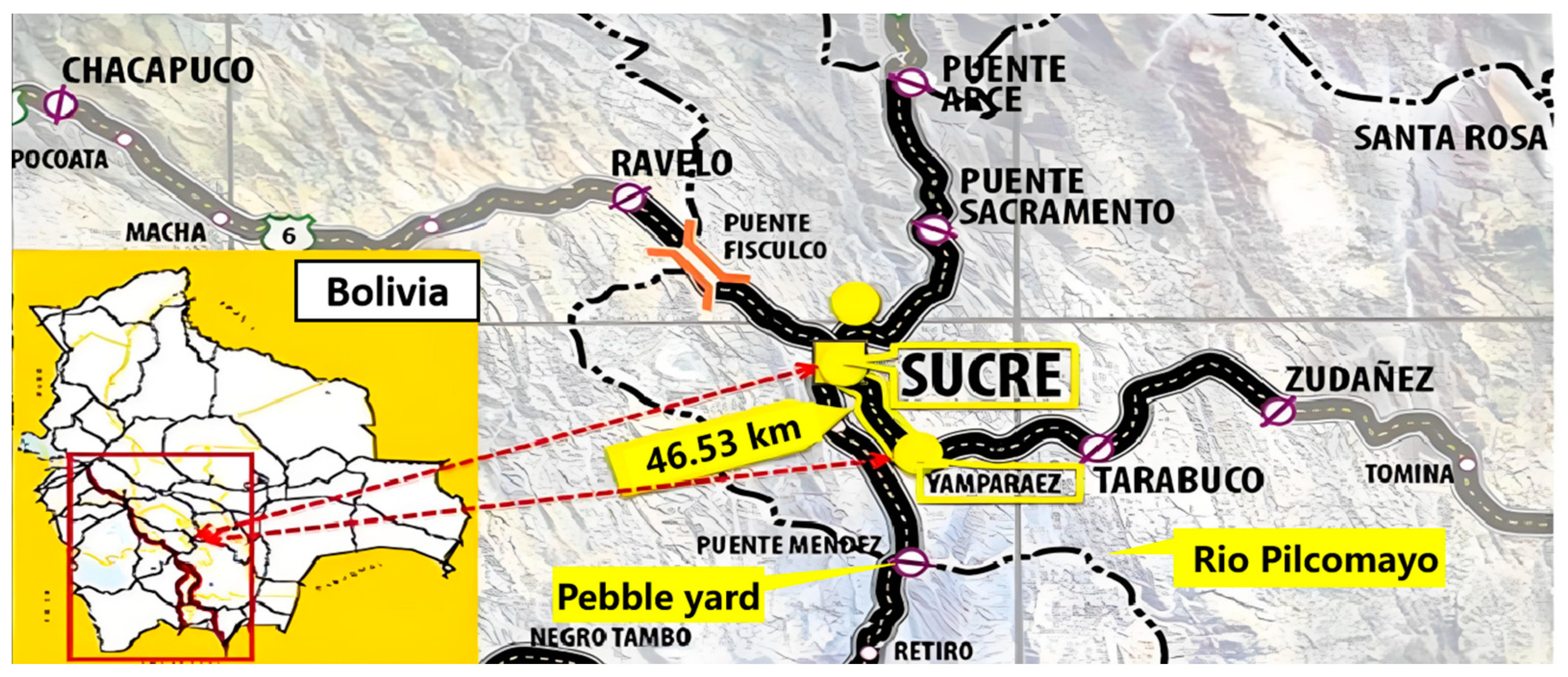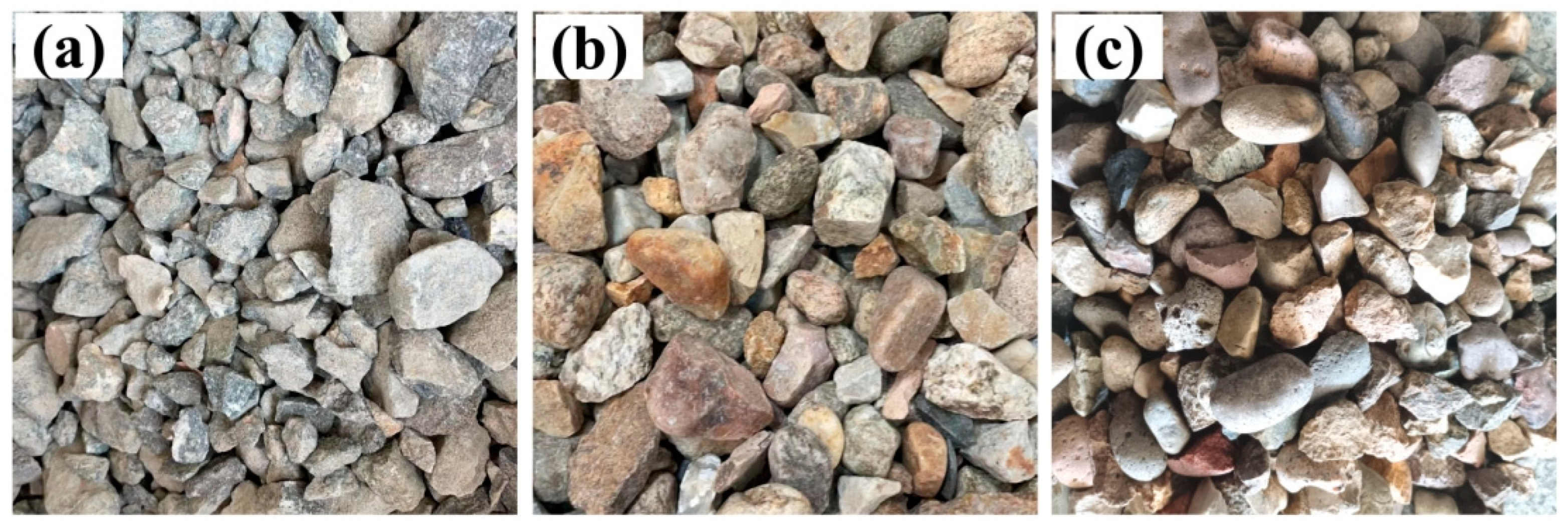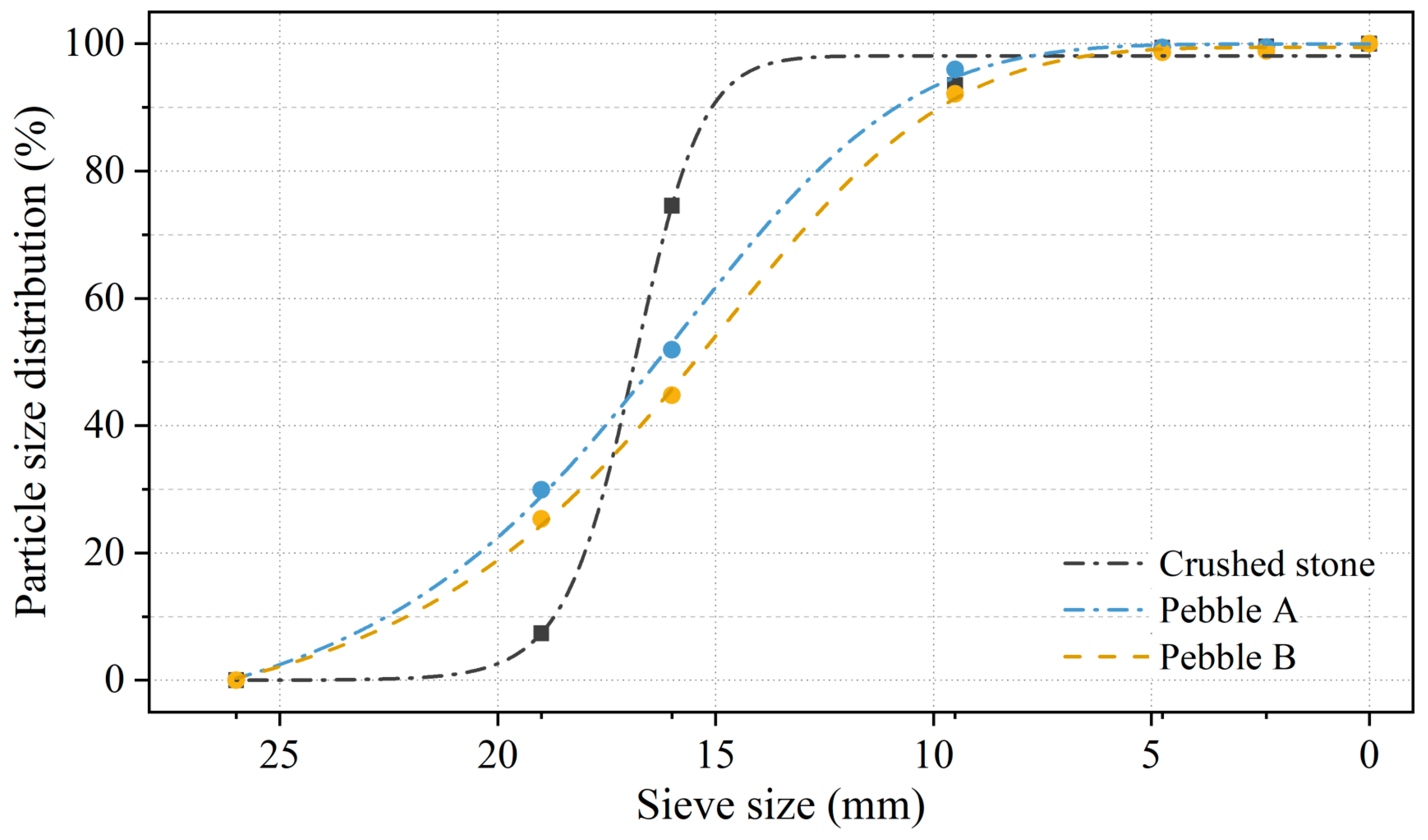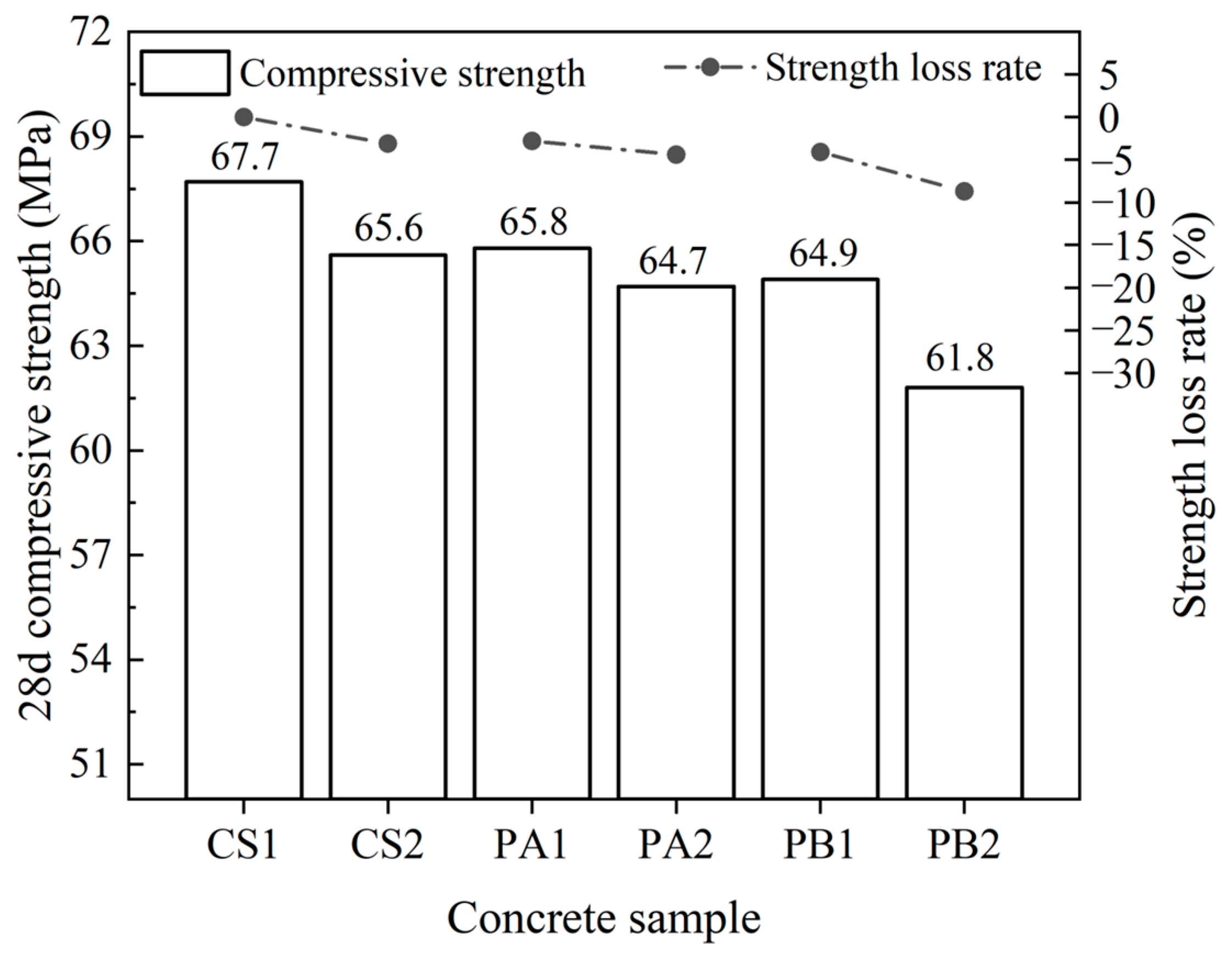Performance Evaluation of Pebble Concrete for Pavement: A Study on the Sucre Highway Project
Abstract
1. Introduction
2. Project Overview
2.1. Project Description
2.2. Geographic and Climatic Conditions
2.3. Main Local Materials
3. Materials and Methods
3.1. Raw Materials
- (a)
- (b)
- The fly ash used was class II, with a fineness (retained on a 45 μm square sieve) of 20.1%, a water demand ratio of 99%, a 7-day activity index of 95%, and a 28-day activity index of 78%. Its chemical composition is detailed in Table 3.
- (c)
- Three types of coarse aggregates were used in the experiment. The crushed stone was supplied by a domestic construction material company, while the pebbles (Pebble A, and Pebble B) were sourced from local rivers in Bolivia. All three aggregates have a nominal maximum particle size of less than 26.5 mm. The appearance of these coarse aggregates is shown in Figure 2. The crushed stone aggregate exhibits an angular surface, while the pebbles display smoother surfaces and better sphericity than crushed stone.
- (d)
- Fine Aggregate: the fine aggregate is Zone II, continuously graded, manufactured sand, with a fineness modulus of 2.5, a stone powder content of 7%, and a methylene blue value of 1.1.
- (e)
- A polycarboxylate-based, high-performance, water-reducing agent was used, with a water reduction rate of 29% and a solid content of 15%.
- (f)
- Tap water from the laboratory was used for the preparation of the concrete.
3.2. Concrete Preparation
3.3. Test Methods
4. Results and Discussion
4.1. Properties of Coarse Aggregates
4.2. Workability of Fresh Concrete
4.3. Mechanical Properties of Harden Concrete
4.3.1. Splitting Tensile Strength
4.3.2. Compressive Strength
4.3.3. Flexural Tensile Strength
4.4. Impermeability of Harden Concrete
5. Conclusions
- Crushed stone aggregate exhibited a crushing value of 4.9%, representing the highest compressive strength. Pebble A and Pebble B had crushing values of 8.3% and 10.5%, respectively. Despite their similar physical properties, both pebbles were inferior to crushed stone in terms of performance, and their gradation was dispersed.
- The type of aggregate and the addition of fly ash significantly influenced the fresh properties of concrete. Due to the smoother surface of pebbles, air entrapment in concrete increased, resulting in higher air content and greater slump, although the impact on flowability was minimal. In contrast, the incorporation of fly ash led to pronounced changes in fresh concrete performance, including a 1% increase in air content, a 70 mm increase in slump, and noticeable improvements in flowability.
- The primary failure modes of pebble concrete included matrix cracking, aggregate fracture, and interface debonding. The type of aggregate and the presence of fly ash had only a minor effect on compressive strength. All concrete types met the flexural tensile strength requirements for heavy/very heavy/extra heavy traffic load levels. However, aggregate crushing value, surface characteristics, and the inclusion of fly ash had significant impacts on flexural tensile strength. Compared to crushed stone, flexural tensile strength decreased by 9.4% and 18.0% for Pebble A and Pebble B concrete, respectively. The addition of fly ash resulted in strength losses, with reductions of 15.7%, 19.2%, and 25.6%, respectively, for the three types of coarse aggregates.
- In crushed stone concrete, the improvement in the interface due to the inclusion of the crushed stone was the dominant factor influencing impermeability, resulting in a water penetration depth of 6 mm. In pebble concrete, however, the improvement in microstructure brought about by fly ash became the primary factor affecting impermeability, enabling the impermeability performance to reach the same level as that of crushed stone concrete. The addition of 25% fly ash achieves a synergy between the utilization of local pebble resources and the durability guarantee of concrete.
Author Contributions
Funding
Institutional Review Board Statement
Informed Consent Statement
Data Availability Statement
Conflicts of Interest
References
- Mundra, S.; Sindhi, P.R.; Chandwani, V.; Nagar, R.; Agrawal, V. Crushed rock sand–An economical and ecological alternative to natural sand to optimize concrete mix. Perspect. Sci. 2016, 8, 345–347. [Google Scholar] [CrossRef]
- Lu, J.; Wang, J.; Guan, Q.; Leng, F.; Zhou, Y.; Li, T. Assessment of the engineering properties of concrete prepared with aggregates developed from waste basalt mud. Case Stud. Constr. Mater. 2024, 21, e03509. [Google Scholar] [CrossRef]
- de Souza Campelo, N.; da Silva Campos, A.M.L.; Aragão, A.F. Comparative analysis of asphalt concrete mixtures employing pebbles and synthetic coarse aggregate of calcined clay in the Amazon region. Int. J. Pavement Eng. 2019, 20, 507–518. [Google Scholar] [CrossRef]
- Wang, L.; Shao, Mi.S.; Wen, Z.B. Effects of Pebble Aggregate in Xinjiang Area on Concrete Performance. Adv. Mater. Res. 2012, 415, 1525–1530. [Google Scholar] [CrossRef]
- Wallevik, O.H.; Feys, D.; Wallevik, J.E.; Khayat, K.H. Avoiding inaccurate interpretations of rheological measurements for cement-based materials. Cem. Concr. Res. 2015, 78, 100–109. [Google Scholar] [CrossRef]
- Wills, M.H. How aggregate particle shape influences concrete mixing water requirement and strength. J. Mater. 1967, 2, 843–865. [Google Scholar]
- Koehler, E.P. Aggregates in Self-Consolidating Concrete; The University of Texas at Austin: Austin, TX, USA, 2007. [Google Scholar]
- Zhao, Y.; Duan, Y.; Zhu, L.; Wang, Y.; Jin, Z. Characterization of coarse aggregate morphology and its effect on rheological and mechanical properties of fresh concrete. Constr. Build. Mater. 2021, 286, 122940. [Google Scholar] [CrossRef]
- Appa Rao, G.; Prasad, B.K.R. Influence of interface properties on fracture behaviour of concrete. Sadhana 2011, 36, 193–208. [Google Scholar] [CrossRef]
- Rao, G.A.; Prasad, B.K.R. Influence of the roughness of aggregate surface on the interface bond strength. Cem. Concr. Res. 2002, 32.2, 253–257. [Google Scholar] [CrossRef]
- Qin, M.; Zhang, G.; Zhang, W.; Li, S. Study on Mechanical Character of C50 Box-beam Concrete with Natural Pebbles. In Proceedings of the 2017 3rd International Forum on Energy, Environment Science and Materials (IFEESM 2017), Shenzhen, China, 25–26 November 2017; Atlantis Press: Amsterdam, The Netherlands, 2018. [Google Scholar]
- Ribeiro, S.; Santos, E.; Garcia, G.; Rodrigues, J. Elastic work and fracture energy of concretes made with crushed stones and pebbles aggregates. Mater. Sci. Forum 2010, 636, 1215–1221. [Google Scholar] [CrossRef]
- He, Y.; Zhang, X.; Hooton, R.; Zhang, X. Effects of interface roughness and interface adhesion on new-to-old concrete bonding. Constr. Build. Mater. 2017, 151, 582–590. [Google Scholar] [CrossRef]
- Li, H.; Gu, X.; Lin, F. Influence of aggregate surface roughness on mechanical properties of interface and concrete. Constr. Build. Mater. 2014, 65, 338–349. [Google Scholar]
- Wu, J.; Feng, M.; Mao, X.; Xu, J.; Zhang, W.; Ni, X.; Han, G. Particle size distribution of aggregate effects on mechanical and structural properties of cemented rockfill: Experiments and modeling. Constr. Build. Mater. 2018, 193, 295–311. [Google Scholar] [CrossRef]
- Ying, L.G.; Ma, B.G.; Zhou, S.Q. Production and engineering application of C60 high-performance pump pebble concrete containing ultra-fine fly ash. Can. J. Civ. Eng. 2008, 35.8, 757–763. [Google Scholar]
- Van Damme, H.; Houben, H. Earth concrete. Stabilization revisited. Cem. Concr. Res. 2018, 114, 90–102. [Google Scholar] [CrossRef]
- Kamisetty, A.; Gandhi, I.S.R.; Kumar, A. Combined effect of fly ash and fiber on spreadability, strength and water permeability of foam concrete. J. Build. Eng. 2023, 78, 107607. [Google Scholar] [CrossRef]
- Boğa, A.R.; Topçu, I.B. Influence of fly ash on corrosion resistance and chloride ion permeability of concrete. Constr. Build. Mater. 2012, 31, 258–264. [Google Scholar] [CrossRef]
- JGJ 52; Standard for Technical Requirements and Test Method of Sand and Crushed Stone (or Gravel) for Ordinary Concrete. China Architecture & Building Press: Beijing, China, 2006.
- GB/T 50080; Standard for Test Method of Performance on Ordinary Fresh Concrete. China Architecture & Building Press: Beijing, China, 2016.
- JTG 3420; Testing Methods of Cement and Concrete for Highway Engineering. People Communications Press: Beijing, China, 2020.
- JTG D40; Specifications for Design of Highway Cement Concrete Pavement. People Communications Press: Beijing, China, 2011.
- GB/T 50082; Standard for Test Methods of Long-term Performance and Durability of Ordinary Concrete. China Architecture & Building Press: Beijing, China, 2024.
- Chen, Z.; Xu, R.; Liang, H. Residual mechanical properties and numerical analysis of recycled pebble aggregate concrete after high temperature exposure and cooled by fire hydrant. Constr. Build. Mater. 2022, 319, 126137. [Google Scholar] [CrossRef]
- Pilegis, M.; Gardner, D.; Lark, R. An investigation into the use of manufactured sand as a 100% replacement for fine aggregate in concrete. Materials 2016, 9, 440. [Google Scholar] [CrossRef] [PubMed]
- Ribeiro, S.; Ribeiro, D.d.C.; Dias, M.B.d.S.; Garcia, G.C.R.; dos Santos, M.B. Study of the fracture behavior of mortar and concretes with crushed rock or pebble aggregates. Mater. Res. 2011, 14, 46–52. [Google Scholar] [CrossRef]








| Local Material | Unit Price/(BS/t) | Description |
|---|---|---|
| Cement | 750 | Freight included |
| Sand | 40 | Excluding freight |
| Local crushed stone | 80 | Excluding freight |
| Pebble A | 40 | Excluding freight |
| Pebble B | 40 | Excluding freight |
| Setting Time/Min | Compressive Strength/MPa | Flexural Tensile Strength/MPa | |||
|---|---|---|---|---|---|
| Initial | Final | 3 d | 28 d | 3 d | 28 d |
| 190 | 300 | 30.90 | 59.30 | 5.20 | 8.60 |
| Binder | SiO2 | Al2O3 | CaO | MgO | K2O | Na2O |
|---|---|---|---|---|---|---|
| Cement | 21.96 | 4.19 | 65.98 | 2.25 | 0.59 | 0.27 |
| Fly ash | 65.23 | 20.98 | 3.09 | 2.02 | 2.12 | 1.37 |
| Sample | Water | Binder | Coarse Aggregate | Sand | Water Reducing Agent | |||
|---|---|---|---|---|---|---|---|---|
| Cement | Fly Ash | Crushed Stone | Pebble A | Pebble B | ||||
| CS1 | 170 | 420 | / | 1018 | / | / | 700 | 10.8 |
| CS2 | 170 | 315 | 105 | 1018 | / | / | 700 | 10.8 |
| PA1 | 170 | 420 | / | / | 1018 | / | 700 | 10.8 |
| PA2 | 170 | 315 | 105 | / | 1018 | / | 700 | 10.8 |
| PB1 | 170 | 420 | / | / | / | 1018 | 700 | 10.8 |
| PB2 | 170 | 315 | 105 | / | / | 1018 | 700 | 10.8 |
| Coarse Aggregate Type | Crushing Value (%) | Apparent Density (kg/m3) | Bulk Density (kg/m3) | Void Content (%) |
|---|---|---|---|---|
| Crushed stone | 4.9 | 2820 | 1452 | 48.5 |
| Pebble A | 8.3 | 2708 | 1430 | 47.2 |
| Pebble B | 10.5 | 2712 | 1431 | 47.2 |
| Sample | Air Content (%) | Slump (mm) | Slump Flow (mm) | Sample | Air Content (%) | Slump (mm) | Slump Flow (mm) |
|---|---|---|---|---|---|---|---|
| CS1 | 6.8 | 125 | / | CS2 | 7.8 | 190 | 510 |
| PA1 | 7.2 | 140 | / | PA2 | 8.1 | 210 | 530 |
| PB1 | 7.3 | 140 | / | PB2 | 8.3 | 205 | 565 |
Disclaimer/Publisher’s Note: The statements, opinions and data contained in all publications are solely those of the individual author(s) and contributor(s) and not of MDPI and/or the editor(s). MDPI and/or the editor(s) disclaim responsibility for any injury to people or property resulting from any ideas, methods, instructions or products referred to in the content. |
© 2024 by the authors. Licensee MDPI, Basel, Switzerland. This article is an open access article distributed under the terms and conditions of the Creative Commons Attribution (CC BY) license (https://creativecommons.org/licenses/by/4.0/).
Share and Cite
Feng, Z.; Lu, J.; Liu, S.; Xia, J.; Wang, J.; Leng, F.; Ma, X. Performance Evaluation of Pebble Concrete for Pavement: A Study on the Sucre Highway Project. Materials 2024, 17, 4994. https://doi.org/10.3390/ma17204994
Feng Z, Lu J, Liu S, Xia J, Wang J, Leng F, Ma X. Performance Evaluation of Pebble Concrete for Pavement: A Study on the Sucre Highway Project. Materials. 2024; 17(20):4994. https://doi.org/10.3390/ma17204994
Chicago/Turabian StyleFeng, Zhuqing, Jue Lu, Simin Liu, Jingliang Xia, Jing Wang, Faguang Leng, and Xinxin Ma. 2024. "Performance Evaluation of Pebble Concrete for Pavement: A Study on the Sucre Highway Project" Materials 17, no. 20: 4994. https://doi.org/10.3390/ma17204994
APA StyleFeng, Z., Lu, J., Liu, S., Xia, J., Wang, J., Leng, F., & Ma, X. (2024). Performance Evaluation of Pebble Concrete for Pavement: A Study on the Sucre Highway Project. Materials, 17(20), 4994. https://doi.org/10.3390/ma17204994







